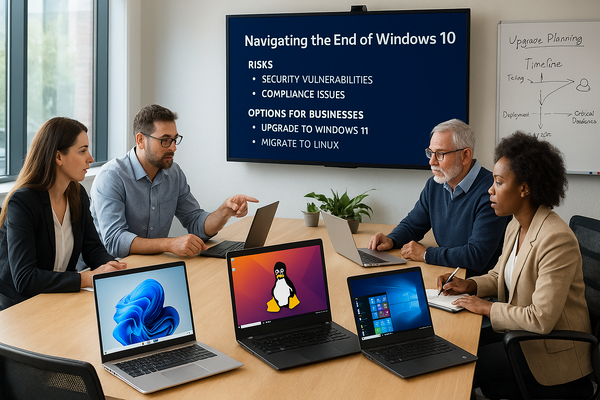
5 Options for Successfully Navigating the end of Windows 10
October 14, 2025 is the designated end-of-support date for Windows 10. As this date approaches, many computer users, and business owners in particular, face critical decisions regarding their investment in desktop, laptop and portable computers .
Understanding the implications, available options, and potential opportunities is essential for navigating this transition effectively and avoiding unwanted outcomes, unnecessary expenditure, increased cyber risk and technology debt.
Impact of Windows 10 End-of-Support
When Microsoft ends support for Windows 10, it will no longer provide security updates, technical assistance, or bug fixes. This cessation poses significant risks, particularly in terms of cybersecurity. Without regular updates, systems running Windows 10 become vulnerable to new threats, making them attractive targets for cybercriminals. For businesses, this means an increased risk of data breaches and operational disruptions - maybe not on October 15th, but certainly in the weeks and months following.
The lack of support will affect system performance and compatibility. Over time, the absence of updates will lead to degraded performance, software and hardware incompatibility, and potential data loss.
Employees will face challenges accessing new software and hardware solutions, impacting productivity and morale. Additionally, businesses may find themselves with compliance issues where industry or government regulations require up-to-date software, leading to potential legal and financial penalties.
Options for Businesses
Businesses have 5 clear options to consider as they prepare for the Windows 10 end-of-support date - these are listed in no particular order and for many businesses, a number of options will be required:
- Upgrade to Windows 11: The most straightforward solution is upgrading to Windows 11, which offers enhanced security features and improved performance. However, this requires hardware that meets Windows 11's requirements, such as TPM 2.0 and Secure Boot. Businesses should use tools like the PC Health Check app to assess compatibility.
- Extended Security Updates (ESU): For businesses unable to upgrade immediately, Microsoft offers Extended Security Updates for up to three years post-support. This program provides critical security patches but comes at a cost (1st Year is A$93 per device!), doubling annually and limited to 3 years. It's available as a temporary measure to buy time for a full transition (if you were to take up this option for the maximum time period, the cost would be approximately A$650 per device).
- Explore Alternative Operating Systems: Some businesses may consider switching to alternative operating systems like Linux or ChromeOS. These systems can offer cost savings and flexibility, though they may require additional training for staff and changes to operational processes and software applications.
- Cloud Solutions: Transitioning to cloud-based solutions, such as Azure Virtual Desktop or AWS Workspaces, allows businesses to access the latest Windows environments without relying on local hardware. This approach reduces the need for physical upgrades and provides scalability and security.
- Maintain Current Systems: While not recommended due to security risks, some businesses may choose to continue using Windows 10 without updates. This option requires robust security measures to mitigate risks.
Preparing for the Transition
To ensure a smooth transition, businesses should take the following steps:
- Conduct a System Audit: Evaluate current hardware and software to determine what needs upgrading or replacing.
- Budget for Upgrades: Plan financially for hardware upgrades or new software licenses.
- Backup Data: Ensure all critical data is backed up to prevent loss during the transition and ensure that access to software license information is readily available.
- Test Compatibility: Verify that essential applications are compatible with Windows 11 or any alternative systems.
- Train Employees: Provide training for staff to familiarize them with new systems and features.
- Engage IT Support: Consider partnering with a Managed Service Provider (MSP) to assist with the transition. An MSP with specialist skills (yes, Microsolve does this!!) in Desktop Operating System migration can offer expertise in deployment, data migration, and ongoing support.
Opportunities and Strategic Considerations
The end-of-support for Windows 10 also presents opportunities for businesses to reassess and optimize their IT strategies:
- Enhance Cybersecurity: Upgrading to Windows 11 or implementing cloud solutions will certainly strengthen cybersecurity measures, protecting sensitive business data.
- Improve Efficiency: New operating systems often come with features that enhance productivity and user experience. Leveraging these can improve workflow and operational efficiency.
- Sustainability Initiatives: Transitioning to newer, more energy-efficient hardware can align with sustainability goals, reducing the environmental impact of IT operations.
- Future-Proofing IT Infrastructure: Investing in modern technology can position businesses to adapt quickly to future technological advancements and market changes.
Conclusion
The end-of-support for Windows 10 is a pivotal moment for business owners, presenting both challenges and opportunities. By understanding the risks and exploring available options, businesses can make informed decisions that align with their strategic goals. Whether upgrading to Windows 11, exploring alternative systems, or leveraging cloud solutions, the key is to plan proactively and engage the necessary resources to ensure a seamless transition. With careful preparation and strategic foresight, businesses can turn this transition into an opportunity for growth and innovation.


